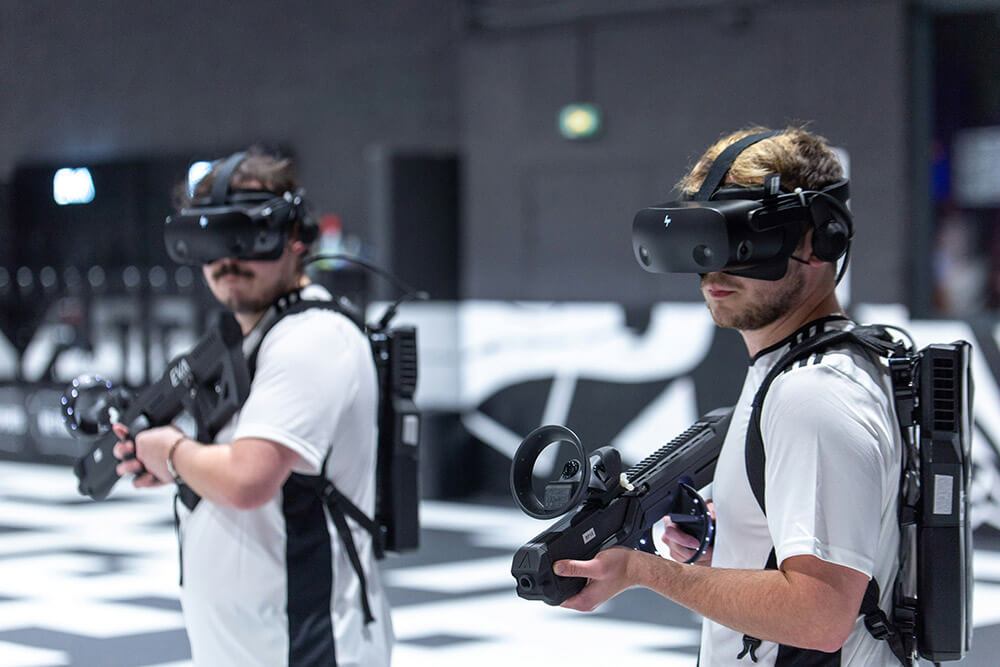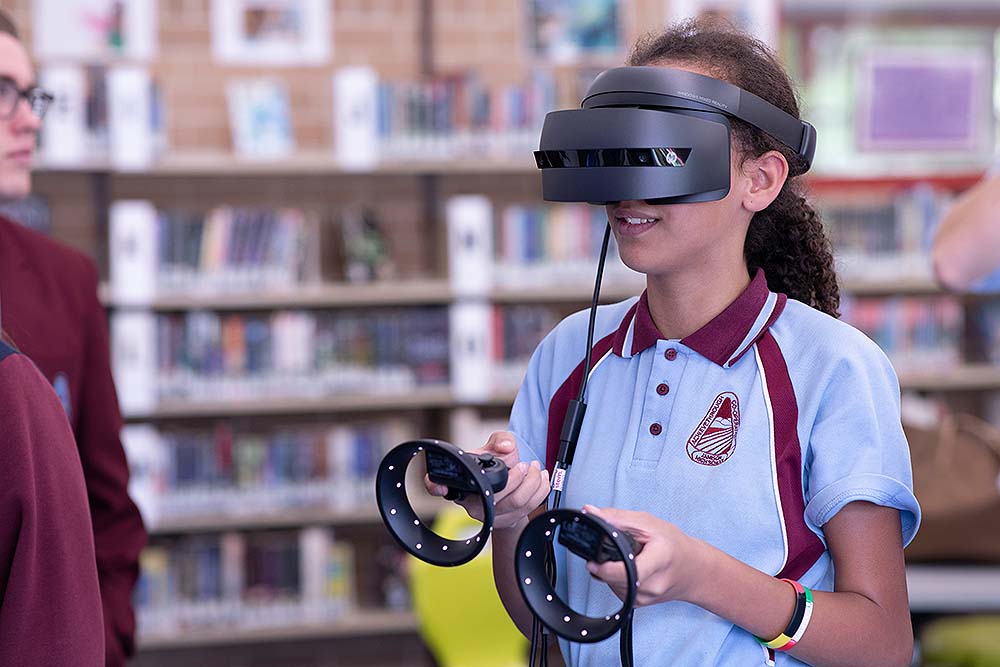
Summary
This research aims to explore Meta Quest, a Virtual Reality(VR) headsets developed by
Meta. The objective is to familiarize the customers for them to navigate or specify
what type of Meta Quest is suited for the different consumers,it discusses on what
type of Quest would be compatible that lets users enjoy the vast environment of
Virtual Reality (VR) . This study indicates Meta Quest journey of continuous
improvements in terms of comfortability, performance and ease of use up until the
trends right now. In this research it will also offer guide tutorials to customers on how
to set up , navigate and use the headset to ensure that they are not intimidated by
the technology. My role as an Applied VR and Game Specialist is not just to help the
consumer to select the right Meta Quest device but also to enhance the Overall VR
experience, ensuring its comfortability and satisfaction by guiding you in this
research.
Introduction
The technology in our world is significantly evolving, reshaping every aspect of our
daily lives. In a world where innovation is moving at the speed of light, technology is
no longer just a tool it has become a necessity, one of the game changing
technologies making a powerful entrance is Meta Quest that’s making a highlight.
So what is Meta Quest? Meta Quest is formerly known as Oculus Quest it represents a
development in Virtual Reality technology offering researchers and developers an
advanced, standalone VR system. It has a unique approach unlike traditional VR
systems that require a PC, the Meta Quest operates independently, providing users
with an immersive VR experience. Meta Quest is paving the way for more accessible
and engaging VR technology.
Research Methodology
This study signifies on how the Meta Quest signifies its use as a “New Education
Product for Quest Devices will help Teachers bring subjects to Life in New Ways” by
Nick Clegg, President Global Affairs. “They also make things possible that are
impossible in the physical world. Instead of telling students what the dinosaurs were
like, they can walk among them. Virtual science laboratories can be built and filled
with equipment that most schools would never be able to afford. Classes can go on
field trips to the best museums, no matter how far away they are. And they can be
used to take the risk out of otherwise dangerous or expensive technical or vocational
training”. It shows how the Meta Quest boardens the imagination of the students by
using this device making the students improve their performance and making it
interesting to learn.
Main Content
- Introduction to Findings
This section provides an overview of how you can understand Meta Quest better. - Key Findings
● 2.1. Meta Quest 3 vs Meta Quest 3S: What’s the Difference?
● 2.2. First Years of VR: A Look at the Greatest Moments from Oculus
● 2.3. Best VR headset in 2025 - Detailed Data
3.1. Meta Quest 3 vs. Meta Quest 3S: WHat’s the Difference? By Will Greenwald
published November 21, 2024. The Meta Quest 3 is one of our favorite VR headsets
and the model we generally recommend to anyone interested in
trying the technology. The Meta Quest 3S is a new step-down version of the Quest 3,
though it’s still a big step up from the four-year-old Quest 2, with color cameras, a
higher resolution, and a faster processor. As its name implies, the Quest 3S is very
similar to the Quest 3 in design and specs. It isn’t the same, though, as is evident by
the $200 difference in price.
Price
This is the most obvious difference between the two. The Quest 3S starts at $299.99,
the same price as the Quest 2 launch, and comes with 128GB of storage, or you can
upgrade to 256GB for $399.99.
Winner: Meta Quest 3S
Design
The Quest 3 and the Quest 3S look almost physically identical, both featuring a white
plastic body and Y- shaped head strap. You can replace those straps on either
headset with three-point Elite Strap($69.99) or the Elite Strap with Battery($129.99),
which means the general fit and feel are close to the same across the board. The
Quest 3’s front panel is curved and features three vertical camera/sensor clusters,
while the front of the Quest 3S is flatter and features two triangular clusters. However,
these differences don’t seem to affect motion tracking or pass- through visibility.
Winner: Tie
Display
This is where the Quest 3S makes the biggest compromise. It has a resolution of 1,832
by 1,920 per eye for 773 pixels per inch. The Quest 3’s resolution is much higher at
2,063 by 2,208 resulting in 1,218 pixels per inch. The Quest 3 also has a wider field of
view at 110 by 96 degrees(horizontal, vertical) compared with 96 by 90 degrees for the
Quest 3S. Both have the same 72Hz, 90Hz, and 120Hz refresh rate modes. The lenses
are also mechanically different, with the Quest 3S using a Fresnel lens with
three-position interaxial distance (IAD) adjustment like the Quest 2, while the Quest 3
has a pancake lens with continuous IAD adjustment like the Quest Poro($1,499.99). IAD
is the distance between the lenses, which corresponds to pupillary distance (PD) or
the distance between your eyes. PD has some wiggle room, and the three positions
for the Quest 3S should have at least one comfortable option for the majority of the
users, but continuous IAD means the Quest 3 can tweak that distance to fit within a
millimeter.
Winner: Meta Quest 3
Cameras
The Quest 3S joins the Quest 3(and jumps far ahead of the Quest 2) in having color
pass-through cameras. They let you see your surroundings in full color, which is very
helpful when using augmented reality or mixed reality software or when you simply
want to stay aware of your surroundings. Both headsets use the same 4MP cameras,
and they work very well even if they don’t have the nearly eye-quality clarity of the
Apple Vision Pro($3,499).
Winner: Tie
Processor
Both headsets are the same here, too, which means Meta doesn’t skimp on the
internal Quest 3S hardware to reduce its price. They both use the Snapdragon XR2 Gen
2 processor with 8GB of RAM, a capable chip designed for mixed reality headsets.
They’re both a bit more advanced than the Meta Quest Pro and its older Snapdragon
XR2+Gen 1, but that headset has an edge memory with 12GB of RAM.
Winner: Tie
Motion Tracking and Controls
Motion tracking is the same for both the Quest 3 and the Quest 3S. They use their
outward-facing cameras to track the position of the headset and the controllers. Both
use the same Meta Quest Touch controllers and offer limited hand-tracking support.
They work equally well, though in both cases, you have to keep the controllers in
front of the headsets to actively follow their movements.
WInner: Tie
Battery Life
The Quest 3S has a smaller battery than the Quest 3 at 4,324mAh to 5,060mAh. That
doesn’t mean it dies quicker, though. Likely because of its lower-resolution display,
Meta claims the Quest 3S can run for about 2.5 hours on a charge while the Quest 3
lasts about 2.2 hours.
Winner: Meta Quest 3S
Storage
We mentioned it above, but the Quest 3 has half a terabyte of storage, while the
Quest 3s comes with either 128GB or 256GB. That means the Quest 3 offers at least
twice as much space as its more affordable sibling.
Winner: Meta Quest 3
Software
The ecosystem is the same for both Meta headsets. They can use Meta’s VR platform,
which has hundreds of apps and games. Both can be tethered to PCs for StreamVR
and other PC-based games with the $79.99 Meta Quest Link Cable.
Winner:Tie
The Verdict
In terms of hardware, the Quest 3 is better because of its superior display, which is
enough of a difference to justify the fact that it’s $200 more expensive. The Quest 3S
is still excellent as its own headset and a fantastic value for the price, with the same
performance and capabilities as the Quest 3. Both are Editors Choice winners, but the
Quest 3S is your bet if you want to experience VR without investing too much, while
the Quest 3 is the strongest pick to really embrace the technology and get the best
picture
Five Years of VR: A Look at the Greatest Moments from Oculus
We released Oculus Rift in March 2016. It was a big moment – the launch of the first
consumer VR headset of the modern era. And it was just the start. We’ve released five
headsets in the past five years, each driving the technology forward and enabling
major improvements in how people interact with VR and the experiences developers
can offer. We wanted to take a moment to celebrate the achievements of so many
who have contributed to making VR what it’s today.
Oculus Rift – March 2016
Before Rift, there was the Kickstarter — a crowdfunding campaign to raise money for
DK1. By 2014, Facebook had acquired Oculus with a vision of VR as the next computing
platform. Rift was the first step toward that vision, a $599 fabric-covered headset with
flip-down headphones, an external sensor, a remote and an Xbox controller.
Oculus Touch Launch – December 2016
Touch enabled players to essentially bring their hands into the virtual world. That
ended up being a key turning point for VR, with games like Robo Recall, SUPERHOT
VR, Arizona Sunshine, The Unspoken and The Gallery. Exploring the possibilities of
this new control scheme and paving the way for Lone Echo, Beat Saber, Asgard’s
Wrath and countless others. By the following summer, Rift and Touch were
permanently bundled together.
Oculus Go – May 2018
Oculus Go reimagined the media-centric Gear VR as an all-in-one device, our first
with better lenses and longer battery life, a sleek new strap-based audio solution,
higher-resolution screens and a mainstream-friendly $199 price point.
Oculus Quest and Rift S – May 2019
In May 2019, we released two headsets on the same day: Rift S and Quest. Each
sported a state-of-the-art inside-out tracking solution (Oculus Insight), higher
resolution panels and a $399 price point. Rift S — a refinement of our previous PC
efforts and Quest — a groundbreaking all-in-one device that offered a relatively
comparable experience without wires or any additional hardware. Making VR more
accessible to more people and helping developers reach new, larger audiences in the
process. By the end of 2019, Oculus Link allowed players to connect Quest to a PC for
a best-of-both-worlds experience. And in 2019, the addition of an innovative hand
tracking solution gave Quest users a glimpse of a more natural and intuitive VR
future.
Oculus Quest 2 – October 2020
Our goal with Quest 2 was to give both players and developers a higher-powered and
more customizable device — and do it for $100 less. That goal grew to be more
difficult when the COVID-19 pandemic hit, but we managed to ship Quest 2 in October
and are already so proud of its success and the success it’s brought developers.
Best VR headset in 2025:
The best VR headsets can make you forget,
even if just for a moment, you’re wearing a big chunk of plastic and foam on your
face. It will make you feel like you’re a part of a game’s world, if only until you walk
into your sofa.
We’ve tested dozens of models, from the most popular to the most obscure, and the
best VR headset is the Meta Quest 3. It’s not just that it’s relatively affordable, it’s one
of few truly new-feeling VR headsets right now. If you’re after something cheaper,
however, the Meta Quest 3S is ready to roll for a lot less cash. It borrows the Quest 3’s
top-notch processor but sticks with the Quest 2’s optics.
Once you’ve secured one of the best VR headsets, the next step is figuring out what
games are worth playing on it. Half-Life: Alyx shows what VR is capable of, but it’ll
push your PC to the limits. There are plenty of other sci-fi titles to enjoy that aren’t as
intense, such as No Man’s Sky. I recommend checking out the best VR games on PC if
you want to build out your library in anticipation.
- Comments regarding the topic
4.1. Meta Quest 3 and Meta Quest 3s represent Meta’s VR strategy offering both a
premium and budget friendly option within the same generation. The Quest 3 is
undoubtedly the more powerful device compared to Meta Quest 3s, it features a high
resolution display making it a design for gamers seeking a more premium VR
experience. On the other hand the Quest 3s is a budget friendly technology making it
affordable to customers at the same time experiencing a VR environment with almost
the same quality not that far off with Meta Quest 3. Overall as a Applied VR and Game
Specialist i can say that Quest 3s is a best to buy if your considering your budget and
you want to experience a VR as its not that far off to Quest 3 in terms of performance
i can say that there is a slight difference in display but overall it has a little
performance gap, but if you have an extra you can go to Quest 3 which offers a better
display and VR experience.
4.2. Throughout the years VR has come a long way making its name in the market, the
Oculus that became what we call now Meta has shaped the entire VR industry these
past few years making it scene worldwide. I believe that Meta will continue to refine
its devices to give us a more thrilling experience in VR as it has a potential in
replacing smartphones / PC in the future, while VR isn’t fully well known to others, its
clear that Meta is leading the way into the top by introducing Meta devices.
4.3. In our modern world where everything around us is evolving, especially the
trends in devices, the Oculus/Quest device has come it’s long way about this. So what
is the best VR headset in 2025? As an Applied Vr and Game Specialist based on my
research and data that i have gathered i can recommend for a better experience is
the Meta Quest 3, why Meta Quest 3? Even though Meta Quest 3 is a bit pricier than 3s
it gives you a more detailed and realistic experience due to its higher resolution, one
of the features on why i recommend the Meta Quest 3 is its “Pancake lenses” it
improves the overall experience of the VR headset due to its thin and compact design
making it called pancake, allowing a slimmer headset design unlike the Quest 2 using
Fresnel lenses making it bulkier. It can maintain a high quality image without the
needs for bulky lenses, reducing its weight and size making it comfortable to the user.
- Conclusion and Recommendations
As an Applied VR and Game Specialist this study conducted on how Virtual reality has
come a long way since its early days, Meta played a vital role in shaping the industry
of VR environment. From its first generation Oculus Rift, which laid the foundation for
modern VR called Meta Quest Series, I see that VR has evolved into a more accessible
and immersive technology for gaming, productivity and social. When comparing the
Meta Quest 3 to Meta Quest 3s, the Meta Quest 3 remains superior due to its high
resolution and better permanence, however when it comes to a budget friendly
alternative the Meta Quest 3s stands on top prioritizing affordability to the
consumers. As of now Meta Quest 3 stands at the best all around VR headset, while
competitors like Apple Vision Pro the Quest 3 still dominate in terms of standalone VR
in the market. I can see different possibilities showing how far the Oculus/ Meta has
improved as it will continuously improve in different aspects.
Here are some of the recommendations on how to operate and navigate VR for the
consumer to easily navigate.
Setting up your VR Headset
Step 1
Check your VR Headset Type VR comes with a different types (META QUEST 2,3)
Step 2
Prepare your Play Area
● Remove obstacles: Furnitures, pets and cables
● Have a light nearby: Some VR systems need ambient light for tracking
● Set up a fan (optional) Helps with motion sickness
Step 3
Set up Your VR Headset- Turn on your headset
- Connect to the Wi-Fi
- Set up Guardian/Boundary System
○ Follow on screen instruction to draw your safe play area
○ Link on the reference for better understanding.
- Pair controllers via Bluetooth
- Download VR apps & games from the built-in store (Quest Store, App Store, Pico
Store)
Step 4
Adjust your VR headset for Comfort
● Adjust head straps – Tight enough to secure but not too tight.
● Lens adjustment – Adjust for clear vision.
● Check for fogging – Use anti-fog wipes or a small fan to prevent lens fog.
● Use VR cover or padding for extra comfort.
Step 5
Test & Optimize Your VR Experience
● Test tracking – Move hands and head, check your movement.
● Calibrate room setup – Make sure boundary warning appear properly.
● Adjust graphic settings – Set refresh rate, resolution, motion smoothing.
You’re Ready for VR! I will provide a link on the reference for better understanding on
how to set up the VR
How to Navigate your VR by step
Navigating in VR depends on whether you’re moving physically inside a VR space,
interacting with menus, or exploring virtual worlds. Below is a step by step guide to
navigating VR effectively.
Step 1
Moving Inside VR - Room-Scale Movement (Walking in Real Life)
How to use: - Clear enough space for movement
- Walk naturally within the boundary
- Teleportation Movement
How to use: - Hold the joystick / thumbstick or press a button
- Point to where you want to go
- Release to instantly “jump” there
- Smooth Locomotion (Joystick/ Analog Stick)
How to use: - Push the joystick in the direction you want to move.
- Adjust movement speed in game settings if needed.
- Arm Swinging / Natural Locomotion
How to use: - Hold the controllers and swing your arms naturally.
- Some VR games / apps detect movement based on hand tracking.
Step 2
Interacting with VR Menus & Objects
- Hand & Controller Interaction
How to use: - Point at objects or UI elements and click.
- Use grip buttons to pick up items.
- Swipe or pinch to scroll through menus.
- Voice Commands & Gaze-Based Interaction
- Look at an object or menu to select it
- Say commands (if supported ex “Open settings”)
Step 3
Navigating VR Worlds & Experiences
- Exploring Virtual Spaces
- Check the in-game tutorial for movement settings
- Follow waypoints or minimaps if available.
- Interact with objects or NPCs
- Navigating VR Web & Interfaces
- Open the VR browser from the home menu.
- Point and select using the controller or pinch gesture.
- Use a virtual keyboard or voice input for searching.
Step 4
Adjusting VR Settings for Better Navigation
- Adjust Guardian / Boundary System – Set up safe movement limits.
- Change Locomotion Mode – Choose teleportation or smooth movement
based on comfort. - Modify VR Comfort Settings – Enable snap turning, vignette effect, or
other anti-motion sickness features. - Optimize Graphics & Tracking – Improve performance for smooth
interactions - References
Nick Clegg, (2024) New Education Product for Quest Devices Will Help Teachers Bring
Subjects to Life in New Ways.
https://about.fb.com/news/2024/04/new-education-product-for-quest-devices/
Will Greenwald, (2024) Meta Quest 3 vs. Meta Quest 3S: What’s the Difference?
https://www.pcmag.com/comparisons/meta-quest-3-vs-meta-quest-3s-whats-the-diff
erence
Hayden Dingman, (2021) Five Years of VR: A Look at the Greatest Moments from
Oculus.
https://about.fb.com/news/2021/03/five-years-of-vr-a-look-at-the-greatest-moments
-from-oculus/
Jacob Ridley, (2025) Best VR headset in 2025: my top picks for stunning virtual reality
experiences.
https://www.pcgamer.com/best-vr-headset/
Setting up guardian/boundary system
Quest 2 Setting Up Guardian
How to pair and unpair your Meta Quest touch controllers
https://www.meta.com/help/quest/967070027432609/
How to Setup your Meta Quest 3
https://share.vidyard.com/watch/wS1pQLMmPo9jfvfi3WfzyA?


